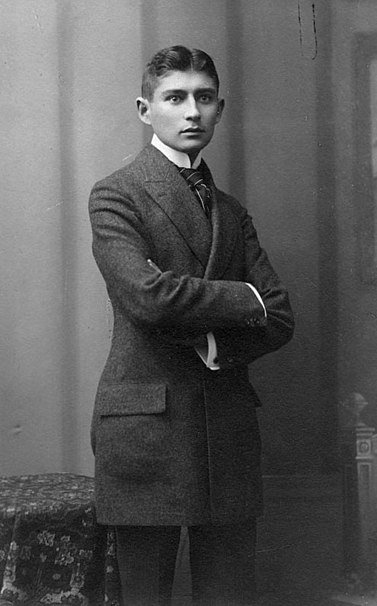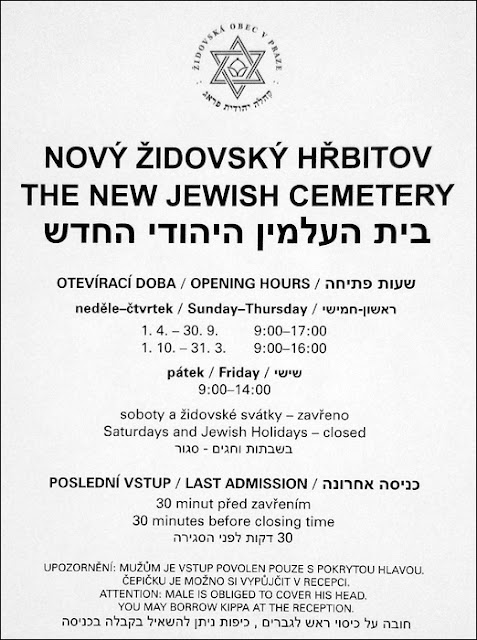FRANZ
KAFKA

[CZ]
Narodil se a zil v Praze, v rodine zidovskeho
velkoobchodníka s galanterii Hermanna Kafky a Julie Kafkove, rozene
Löwyove; mel dva bratry, Georga a Heinricha, ale oba zemreli v
detském veku, a tri sestry, Elli, Valli a Ottlu, vsechny byly
pozdeji obetmi nacistickeho teroru a zemrely v koncentracnich
taborech. Se svym otcem nevychazel dobre, coz ovlivnilo nejen jeho
detstvi, ale i dílo – citil se osamoceny, bezmocny. Po Praze
se priblizne 14krat stehovali. To vyvolavalo v Kafkovi smisene
pocity k tomuto mestu. Kafkova materstina byla nemcina, ale hovoril
take cesky a castecne francouzsky. Ackoli byl Zid, neumel
hebrejsky. Teprve az v poslednim roce zivota se zacal hebrejstinu
ucit.
Dílo
Za nejdulezitejsi Kafkovy prace jsou vseobecne povazovany romany
Proces, Nezvestný (tez zvany Amerika), Zamek a povidka Promena.
Stezejni cast Kafkova dila byla za jeho zivota temer neznama,
publikoval jen nekolik kratkych povidek. Proslulosti dosahl Kafka
az po sve smrti, zejmena po 2. svetove valce, a dnes patri ke
klasikum literatury 20. stoleti a jednem z nejvetsich inovatoru
romanove formy vypraveni. V jeho dile se projevuje jeho osobni
dusevni rozpolcenost; pocit vyrazenosti a izolovanosti jsou
dulezitymi motivy jeho tvorby. Kafka byl silne psychicky
nestandardni osobnost a sve tryznive a desive vnitrní vize promital
do tvorby.
Hlavni temata, ktera Kafku zajimala a doslova
vzrusovala byla: moc, výkon moci a její dopad na poddane osoby, a
jedinec uprostred tohoto vseho.
Kafkovi vlastnim stylem je misty až neuveritelne
podivne humorne liceni, jez neni ale nijak komentovano, kdy autor
patrne bavil predevsim sam sebe. Dalsim podstatnym rysem Kafkova
stylu je zaliba, touha byt ponizovan (vubec nejdulezitejsi rys),
jeho hrdinove se take prave predmetem ponizovani stavaji. Nicmene
vse je nazirano ironicky, s osobitym humorem autora. Chmurnost jeho
pribehu vyplyva z ukonceni, ktera jsou zpravidla tragicka,
bezvychodna, nepotesujici. Kafka timto pouze odrázel stav okolo
sebe a v romanovem svete svych postav tento pocit pouze prehanel a
dovadel do temnych dusledku.
[EN]
Kafka was born into a middle-class, German-speaking
Jewish family in Prague, the capital of Bohemia (now the Czech
Republic). He was the eldest of six children. He had two younger
brothers, Georg and Heinrich, who died before Kafka was seven, and
three younger sisters, Elli, Valli, and Ottla. Kafka's sisters all
perished in German concentration camps.
None of Kafka's novels was printed during his lifetime,
and it was only with reluctance that he published a fraction of his
shorter fiction. This fiction included Meditation (1913; Eng.
trans., 1949), a collection of short prose pieces; The Judgment
(1913; Eng. trans., 1945), a long short story, written in 1912,
which Kafka himself considered his decisive breakthrough (it tells
of a rebellious son condemned to suicide by his father); and The
Metamorphosis (1915; Eng. trans., 1961), dealing again with the
outsider, a son who suffers the literal and symbolic transformation
into a huge, repulsive, fatally wounded insect. In the Penal Colony
(1919; Eng. trans., 1961) is a parable of a torture machine and its
operators and victims--equally applicable to a person's inner sense
of law, guilt, and retribution and to the age of World War I. The
Country Doctor (1919; Eng. trans., 1946) was another collection of
short prose. At the time of his death Kafka was also preparing A
Hunger Artist (1924; Eng. trans., 1938), four stories centering on
the artist's inability either to negate or come to terms with life
in the human community.
Contrary to Kafka's halfhearted instruction that his
unprinted manuscripts be destroyed after his death, his friend Max
Brod set about publishing them and thus became the architect of his
belated fame. The best known of the posthumous works are three
fragmentary novels. The Trial (1925; Eng. trans., 1937) deals with
a man persecuted and put to death by the inscrutable agencies of an
unfathomable court of law. The Castle (1926; Eng. trans., 1930)
describes the relentless but futile efforts of the protagonist to
gain recognition from the mysterious authorities ruling (from their
castle) the village where he wants to establish himself. Amerika
(1927; Eng. trans., 1938), written early in Kafka's career,
portrays the inconclusive struggle of a young immigrant to gain a
foothold in an alien, incomprehensible country. In all of these
works, as indeed in most of Kafka's mature prose, the lucid,
concise style forms a striking contrast to the labyrinthine
complexities, the anxiety-laden absurdities, and the powerfully
oppressive symbols of torment and anomie that are the substance of
the writer's vision. Kafka's fiction, somewhat like ink-blot tests,
elicits and defeats attempts at conclusive explanation. Practically
every school of modern criticism has produced a corpus of
interpretations. Kafka's own aphorisms, however, may come the
closest to offering a key.
NOVY ZIDOVSKY HRBITOV / NEW JEWISH
CEMETERY

Pro ty, co nevidi obrazek nahore / For those, who can't
see the picture above:
Oteviraci doba / Opening hours
Nedele / Sunday - Ctvrtek / Thurstday: 9:00 -
16:00
Patek / Friday: 9:00 - 14:00
Sobota a zidovske svatky/ Saturday and jewish holidays: Zavreno /
Closed
Posledni vstup 30 minut pred zavrenim. / Last admission 30 minutes
before closing time.
[CZ]
Byl zalozen v roce 1891, kdyz doslouzil Stary zidovsky
hrbitov v dnesní Fibichove ulici. Byl proponovan pro cca 100 000
hrobu, tedy asi na jedno století. Svou rozlohou je vice nez 10 x
vetsi nez Stary zidovsky hrbitov v Josefove. Obradni sin s
dustojnou modlitebnou, dum ocisty pro pohrebni obrady, budovy
spravní a pomocne i ochranna zed kolem hrbitova byly zbudovany v
tehdejsim vladnoucim stavebnim slohu - v novorenesanci. Obradni sin
navrhl architekt Bedrich Münzberger. Hrbitov byl od pocatku radne
rozdelem na hrbitovni pole, ktera byla postupne zaplnovana hroby,
takze prochazka hrbitovem je i prehledem jednotlivych po sobe
jdoucich slohu hrobek a pamatniku mrtvych: od novogotiky pres
novorenesanci, prazskou a videnskou secesi, pres klasicismus,
purismus a konstruktivismus az k soucasnosti. Na hrbitove se
pohrbiva dodnes. Mnohe umelecky hodnotne nahrobky jsou dily
prednich ceskych socharu a architektu - Jana Kotery, Josefa Zasche,
Josefa Fanty, Cenka Vosmika aj.
Ve stredu hrbitova u hlavni aleje je pole venovane
pracovnikum zidovskych nabozenskych obci a dalsich vyznamnych
cinitelu, pri vstupu na hrbitov je misto pro cestne hroby
vyznamnych rabinu jako napr. dr. Nathan Ehrenfeld nebo dr. Gustav
Sicher a take pamatnik Patria, pamatnik zanikle dolnokralovicke
obce ve tvaru obycejneho balvanu a Pamatnik obeti 1. svetove valky
z r. 1926 ve tvaru obdelneho kvadru vsazeneho do dvou obdelnikovych
podstavcu. Podel vychodni hrbitovni zdi jsou nakladne rodinne
hrobky, napr. vyznamnych podnikatelskych rodin Petschku a Waldesu.
Waldesovska hrobka je zdobena dvema reliefnimi bustami - poslednim
dilem Josefa Vaclava Myslbeka.
Odpociva zde take napr. spisovatel Ota Pavel, v urnovem
haji napr. basnik Jiri Orten. Hrbitov ma zvlastni povoleni
provozovat urnovy hyj, prestoze zidovska tradice zakazuje kremace
mrtvych. Teto moznosti vyuzivaji zejmena smisena manzelstvi.
Novy zidovsky hrbitov v Praze 3
je jako celek zapsan mezi chranene kulturni pamatky.
[EN]
The New Jewish Cemetery in Prague 3 is a preserved
cultural monument as a whole ; due to its character, disposition
and a hundred-year excellent administration supported by a
considerable role the Hevra Kaddisha (burial society) played in
Prague's Jewish community. The Hevra Kaddisha saw to it that graves
were established in cemetery lots both chronologically and in
accordance with the family's wish and significance which played its
natural and social roles even at the moment of death in the
bourgeois society. The Hevra Kaddisha also saw to it that
inscriptions on tombstones were truthful and testifying to the
buried person's character.
Since its establishment in 1891, the cemetery
has been surrounded by the wall protecting the space for some
100.000 graves, i. e. for about one century. There were also
structures built in the building style that prevailed in Prague in
those times - neo-Renaissance. It is the style of the funeral
parlor with a respectable hall of prayer, and adjacent rooms needed
for the ritual preparation of the burial ; as well as the
administration building including the cemetery caretaker's office
and his and gravediggers' apartments, and other structures such as
a storehouse of wood used to make coffins. Since the very
beginning, the cemetery has been properly divided in lots which
were gradually used as graves ; and a walk around the cemetery also
gives an idea of the styles in which the tombs were built. The
cemetery is situated on a hill sloped from the north down to the
south and from the west down to the east, in a basin in its
southeastern part where a columbary with its own funeral parlor was
added in the 20s. Originally, it was completely separated and now
it is connected with the main cemetery by means of passageways. The
division of the cemetery suggested a significant architecture of
tombstones for the graves situated at the corner of individual lots
as well as the graves situated near main alleys - particularly in
the alley were a burial procession walked from the funeral parlor
down to the grave. The New Jewish Cemetery which will never be
completely filled with graves because the devastating blast of
Nazism exterminated those who could and should have rested here one
day, is a homogenous architectural monument.
Zdroj/Source:
Internet
CACHE
[CZ]
Uvedene souradnice vas dovedou pred hrob
Franze Kafky. Priblizne za nim se nachazi pomerne velky hrob rodiny
Margoliusovych.
A = posledni cislice v roce narozeni Karoliny
B = posledni cislice v roce narozeni Salomouna
C = posledni cislice v roce narozeni Rudolfa
50° 4.(B + C - 2)(B * C + 4)
14° 28.(A + C + 1)(B - A - 1)(B - C - 3)
Dosazenim do uvedeneho vzorce ziskate souradnice hrobu
Emila Lederera. Pokud vam vychazeji zaporna cisla, tak se jeste
jednou zamyslete, kolik let bylo Karoline a Salomounovi, kdyz
umreli.
D = posledni cislice v roce umrti Emila
Dosazenim do nasledujiciho vzorce ziskate finalni
souradnice.
50° 4.(D - A - 1)(D + 1)(C - 1)
14° 28.(D - C + 1)(B + 1)(D + 1)
[EN]
Coordinates above will direct you in front of Franz Kafka's grave.
There is a relatively big grave of Margolius family approximately
behind Kafka's grave.
A = last numeral in year of birth of Karolina
B = last numeral in year of birth of Salomoun
C = last numeral in year of birth of Rudolfa
50° 4.(B + C - 2)(B * C + 4)
14° 28.(A + C + 1)(B - A - 1)(B - C - 3)
Now you have a coordinates of grave of Emil Lederer. If
in the result are negative numbers, think again how old was
Karolina and Salomoun when they died. (The translation of the sign
is: He died on February 17th 1924 in 78th year of his life.)
D = last numeral in year of death of Emil
And here are the final coordinates.
50° 4.(D - A - 1)(D + 1)(C - 1)
14° 28.(D - C + 1)(B + 1)(D + 1)